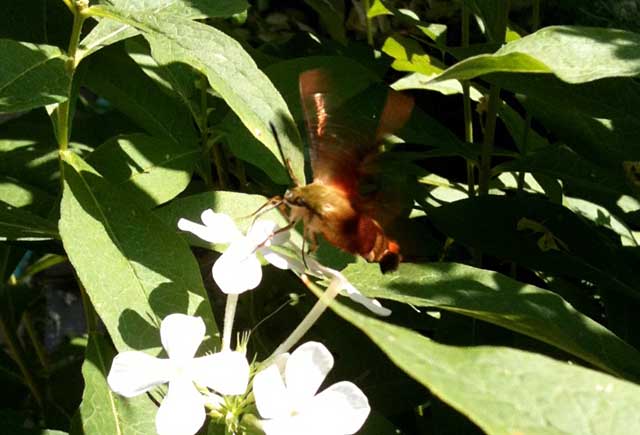Sphinginae subfamily
Sphingini tribe:
 |
This species is enountered in Dukes County as a stray from
much further south.
The moth is a very strong flier and is
frequently encountered far north of its usual range.
|
 |
Ceratomia amyntor
WO,
the Elm Sphinx or Four-horned Sphinx
This moth is not officially recorded in Barnstable, but it
probably flies throughout the state.
Larvae feed on Elm (Ulmus), birch (Betula), basswood (Tilia), and cherry (Prunus). |
 |
This is generally a more southerly species, but it may be present in Dukes County near Catalpa Trees.
I saw them in great numbers in New Jersey. The larvae feed in large groups and are much more
spectacular than the moths.
Catalpa is the larval host. |
 |
This moth is not recorded in Dukes County, but it has been observed to the north, west and south.
It is named
for the wavy lines on the forewings. |
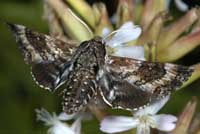 |
This moth is recorded in Barnstable and
it has been taken to the north, west and south. Larve are not limited to pawpaw.
|
 |
Reported from Dukes, it is widely
reported in Massachusetts and along the coast in New Hamshire and
Vermont. This is another one we have on P.E.I.
|
 |
This species is officially reported from Dukes and
it is widely reported in Massachusetts and along the coast in New
Hamshire and Vermont. If you've got pines, this species is likely present.
|
 |
This species is present in Dukes County.
The upperside of the forewing is gray-brown with wavy lines, black dashes, and one or
two small white spots near the center of the costa.
|
 |
This species is not recorded in Barnstable County and usually is not found
north of Connecticut. This moth is a strong flier and may occasionally
stray into Massachusetts.
|
 |
This species is not recorded in Barnstable County, but I suspect if you
grow tomatoes you have encountered it.
|
 |
This species is not officially recorded in Barnstable County.
However, if you grow tomatoes, you have probably encountered it.
Larvae get very large and can strip a tomato plant. |
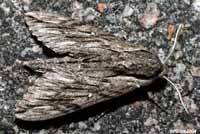 |
This species is recorded in Dukes County, but probably would not be common,
as this would be the northernmost part of
range.
The upperside of the forewing is gray with indistinct black
and white markings.
|

|
Sphinx canadensis
WO,
Sphinx canadensis, the Canadian Sphinx, is not common, and is not
often reported anywhere,
but it might be present in Barnstable County as it is reported from
further west.
Larval hosts are white ash (Fraxinus americana) and blueberry
(Vaccinium).
|
 |
Sphinx chersis
WO, the Northern Ash Sphinx or Great Ash Sphinx
This species is not officially recorded from Barnstable County.
Larval hosts are ash, lilac, privet, cherry, and quaking aspen.
|
 |
This species is present in Barnstable County. We have them on P.E.I.,
but I do not see them nearly as frequently
as I see the other Sphingidae.
|
 |
This species is present in Barnstable County.
Colouration and markings are highly variable from one specimen to
another. The fringes on forewing are mostly
black with some white; those on the hindwing are mostly white with a
few black patches.
|
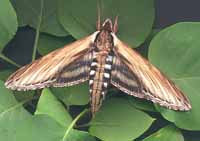 |
This species is reported in Barnstable County.
I have taken them on P.E.I., Canada, and reared them on
lilac. At rest the hindwings are usually completely covered.
|
 |
Sphinx luscitiosa
WO,
the Canadian Sphinx or
Clemen's Sphinx:
Upperside of fw is yellowish gray in males and pale
gray with faint yellow tint in females. Dark
border on outer margin widens as it approaches inner margin.
Upperside of hw is deep yellow in males,
pale yellow in females; both with wide black border.
|
 |
Sphinx poecila
WO, maybe, the Poecila Sphinx
If you have blueberries in the woods, then you probably have the Poecila Sphinx.
They are pretty common here on Prince Edward Island, but don't fly
too far south of Massachusetts, being replaced by Sphinx gordius
in Connecticut. |
Smerinthini Tribe:
 |
This is the first Sphinx species I reared as a boy in New Jersey.
See the file for the female; she is different. |
 |
Pachysphinx modesta
WO, the Modest Sphinx or Poplar Sphinx
This moth is not officially reported from Dukes County, but it may be
present.
They are common on Prince Edward Island. |
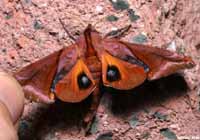 |
It is widely distributed
in Massachusetts, but is a relatively uncommon species.
Only rarely are they seen in Maine. I never saw one in New Jersey.
|
 |
Named for the dull grey-blue spot in the hindwing, this moth has a
wide distribution and is probably common in Barnstable County.
I regularly see them on Prince Edward Island, and they are reported as far south as Florida. |
 |
Named for the small eye-spot in the hindwing, this moth has a wide
distribution and is probably common in Barnstable County.
I regularly see them on Prince Edward Island, and they are reported
as far south as Florida.
|
 |
is probably at near its southern limit of
the eastern range for this species. I never saw
one in New Jersey. At my home in Montague, P.E.I., Canada, they are quite common. |
 |
This moth is widely distributed and fairly common and has been
recorded in Barnstable County.
Along the East Coast, it flies from P.E.I. to Florida. |
Macroglossinae subfamily
Dilophonotini tribe:
 |
Hemaris thysbe
LKC, the
Hummingbird Clearwing This interesting day flier is now confirmed for
Barnstable.
They are widely distributed in the east from P.E.I. to Florida.
|
Hemaris thysbe, Barnstable, September 2, 2010, LKC
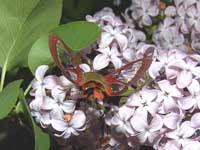 |
Hemaris gracilis
WO, The Slender Clearwing or Graceful
Clearwing
This day flier is not commonly reported, but is probably present in Barnstable.
|
 |
Hemaris diffinis WO, the Snowberry Clearwing or Bumblebee Moth
This moth is widely distributed and often reported north, west and
south of Dukes (not yet reported for Dukes).
|
Philampelini tribe:
 |
This moth is reported for barnstable,
and it is fairly often reported
along the coast from southern New Jersey
to central Maine.
Note the differences between this moth and the Pandorus Sphinx. |
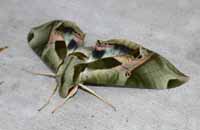 |
If you have Grape or Virginia Creeper nearby, then you probably have
this species. I often get asked to identify larvae from areas where
they have not previously been reported.
|
Macroglossini tribe:
 |
This day flier is widely distributed although not
officially recorded in Dukes County. If you have Virginia Creeper,
you probably have the Nessus Sphinx.
Two bright, distinct, narrow yellow
bands are often visible on the abdomen.
|
 |
Cautethia grotei
WO, possible unlikely stray, Grote's Sphinix
The upperside of the forewing is pale silvery gray with black
markings. The upperside
of the hindwing is deep yellow-orange with a black border that
covers less than half the wing. rare
|
 |
They are common in New Jersey and common
here on Prince Edward Island.
You will often see this species listed as Darapsa pholus,
especially in older literature.
It is reported on USGS for Dukes. |
 |
Darapsa myron USGS, the Virginia Creeper Sphinx or the Grapevine Sphinx
This moth is recorded on the USGS site for Dukes County.
It is widely reported as far north as southern Maine. If you have the foodplants
indicated in the common names, you probably have this species nearby. |
 |
If you have hydrangea growing near a stream, then you may have the
Hydrnagea Sphinx. It has not been widely reported, however, and
probably is uncommon.
|
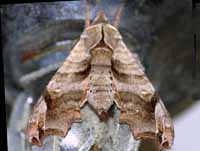 |
This species has not been recorded in Barnstable County, but it has been
reported in nearby Massachusetts counties
and may be present.
It is generally absent to the north so would probably be uncommon. |
 |
Hyles gallii WO , the Bedstraw Hawk Moth
or Gallium Sphinx
This species is reported in nearby counties.
Some years I see them on P.E.I., some years, I do not.
|
 |
Hyles lineata WO , the White-lined Sphinx
This species is not officially reported from Barnstable County.
It is a strong migrator from the south,
and there are records from the west and to the north. |
 |
This moth is very much under reported. It is a
rapid day flier so is probably not in too many collections.
Grape is a popular larval host.
|
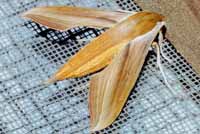 |
Xylophanes tersa USGS, probably as a non-resident stray,
the Tersa Sphinx
The upperside of the forewing is pale brown with lavender-gray at the base and has dark brown lengthwise lines
throughout. The upperside of the hindwing is dark brown with a band of whitish, wedge-shaped marks.
|
|
|
